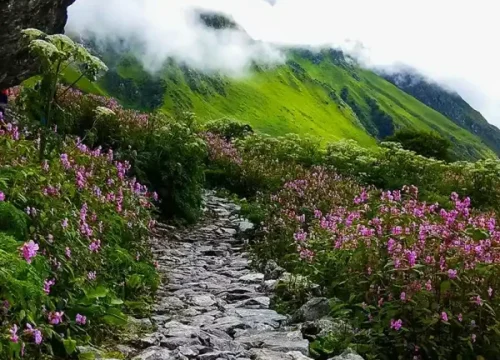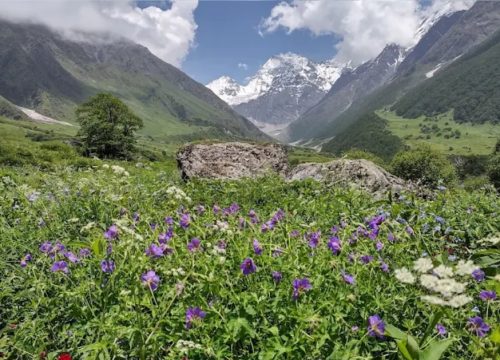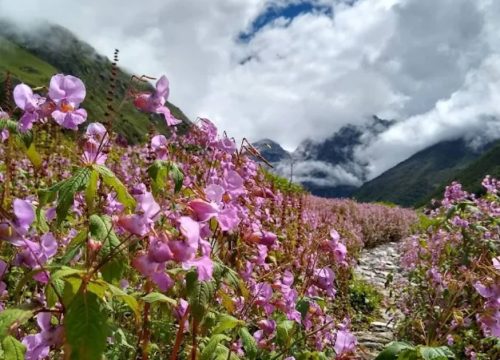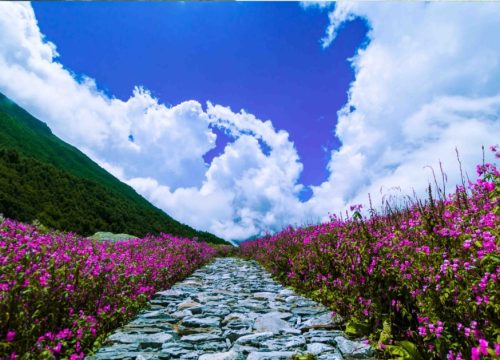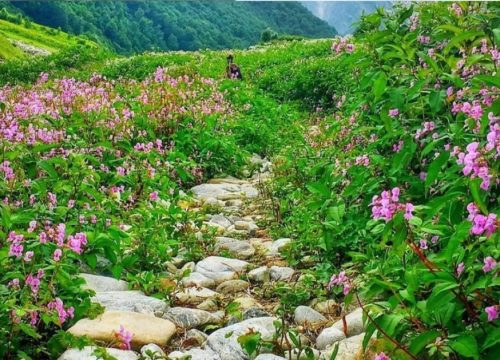Valley Of Flowers Trek
Valley Of Flowers Trek
The Valley of Flowers Trek is one of India’s most enchanting Himalayan journeys, celebrated for its spectacular alpine meadows, vibrant floral diversity, and breathtaking mountain scenery. Located in the Chamoli district of Uttarakhand, within the Nanda Devi Biosphere Reserve, the trek is a UNESCO World Heritage Site, drawing trekkers, nature enthusiasts, and photographers from around the world.
The trek begins at Govindghat (1,800 m), from where a short drive or trek takes you to Ghangaria (3,050 m), the base camp for exploring the valley. From here, trekkers venture into the Valley of Flowers National Park (3,200–3,600 m), a natural paradise famous for its endemic Himalayan flora. During peak flowering season (July–August), the valley transforms into a riot of colors with hundreds of species of flowers, including blue poppies, Himalayan orchids, primulas, and potentillas, along with medicinal herbs cherished by local communities.
How to Reach Valley Of Flowers Trek
Reaching the Valley of Flowers Trek involves traveling to the base of the trek at Govindghat (1,800 m) in Uttarakhand, from where the trek officially begins. The journey passes through scenic roads of the Garhwal Himalayas, charming villages, and lush valleys, offering a glimpse of the natural beauty even before the trek starts.
🛫 By Air
Nearest Airport: Jolly Grant Airport (Dehradun, DDN), approximately 275 km from Govindghat.
Connectivity: Flights connect Dehradun with Delhi, Mumbai, and other major Indian cities.
From Airport to Govindghat:
Taxi/Private Cab: Around 10–11 hours via Rishikesh, Devprayag, Joshimath, and Badrinath route.
Combination of Bus and Taxi: Public transport is available, but private cabs are faster and more convenient.
🚂 By Train
Nearest Railway Station: Rishikesh Railway Station (approximately 270 km).
From Rishikesh, you can:
Hire a taxi or cab to Govindghat (10–11 hours).
Use bus services to reach Joshimath and then take local transport to Govindghat.
🚌 By Road
Govindghat is well-connected by roads from Rishikesh, Haridwar, and Dehradun.
Private Taxis: Comfortable and preferred, especially with luggage and trekking gear.
Public Buses: Limited services; can be used from Rishikesh or Joshimath to Govindghat.
The road route passes through Rishikesh → Devprayag → Karnaprayag → Chamoli → Joshimath → Govindghat, offering views of rivers, mountains, and terraced hillsides.
🏞️ From Govindghat to Ghangaria (Base Camp)
Trek begins from Govindghat, either on foot or using porters/mules for luggage.
Distance: ~13 km, generally covered in 5–6 hours.
Trail passes through beautiful forests, small streams, and quaint villages, gradually ascending to Ghangaria (3,050 m).
Stay: Simple guesthouses or camps in Ghangaria before entering the Valley of Flowers.
🛕 Permits and Regulations
Valley of Flowers National Park is a protected area; entry requires permits available at Govindghat or Ghangaria.
Indian citizens need a government-issued ID (Aadhaar, Voter ID, Passport), and foreign nationals require a passport and Indian visa.
Guided treks are recommended for safety and orientation, especially for first-time trekkers.
🗺️ Travel Summary
Fly or train to Dehradun Airport or Rishikesh Railway Station.
Drive or take a bus to Govindghat (10–11 hours).
Trek 13 km to Ghangaria, the base camp.
Begin the Valley of Flowers trek, exploring the valley and optional Hemkund Sahib extension.
Near Places To Valley Of Flowers Trek
1. Govindghat (1,800 m) – Trek Base
Govindghat is the starting point for the trek to the Valley of Flowers and Hemkund Sahib. While a small town, it has essential services:
Accommodation & Supplies: Guesthouses, hotels, and shops for trekking gear and food.
Cultural Exposure: Small local markets and temples giving a glimpse of Garhwali life.
River Views: Located along the Alaknanda River, ideal for photography and relaxation before the trek.
2. Ghangaria (3,050 m) – Base Camp Village
A quaint alpine village at the foot of the Valley of Flowers, Ghangaria offers:
Accommodation: Tea houses and guesthouses for trekkers.
Local Cuisine: Simple, high-altitude meals like dal, rice, and momos.
Gateway to Nature: Starting point for Valley of Flowers and Hemkund Sahib; surrounded by dense forests and meadows.
3. Hemkund Sahib (4,330 m)
A revered Sikh pilgrimage site located beside a glacial lake. It’s a significant extension of the Valley of Flowers trek:
Spiritual Experience: Pilgrimage site visited by thousands during the season.
Scenic Views: Glacial lake, surrounding snow-capped peaks, and high-altitude flora.
Photography: Stunning sunrise and sunset views reflecting on the lake.
4. Joshimath (1,890 m)
A nearby town acting as a gateway to several treks in the Garhwal region:
Travel Hub: Connection point for Badrinath, Auli, and Valley of Flowers.
Temples & Monasteries: Narsingh Temple and Shankaracharya Math provide spiritual and cultural insights.
Cable Car to Auli: Offers panoramic views of Himalayan peaks and meadows.
5. Badrinath (3,133 m)
Approximately 50 km from Govindghat, Badrinath is one of the Char Dham pilgrimage sites:
Spiritual Attraction: Badrinath Temple, dedicated to Lord Vishnu.
Scenic Landscapes: The Alaknanda River, snow-capped peaks, and Himalayan meadows.
Cultural Experience: Local markets and festivals showcase Garhwali traditions.
6. Auli (2,800 m)
A popular hill station and skiing destination:
Adventure Activities: Skiing, cable car rides, and trekking.
Panoramic Views: Himalayan peaks including Nanda Devi, Kamet, and Mana.
Acclimatization Stop: Perfect for travelers coming from lower altitudes before starting the Valley of Flowers trek.
7. Rishikesh & Devprayag (Lower Valley Route)
While a longer distance from the trek base, these places are ideal for pre-trek acclimatization and cultural experiences:
Rishikesh: Yoga capital of India, river rafting on Ganga, and temples.
Devprayag: Confluence of Alaknanda and Bhagirathi rivers; scenic and spiritually significant.
Other Tours
- Adi Kailash
- Aulli
- Bali Pass Trek
- Bararsar Lake
- Borasu Pass Trek
- Brahmatal Trek
- Chopta
- Dayara Bugyal Trek
- Goechala Trek
- Har Ki Dun Trek
- Haridwar
- Jungle Safari
- kausani
- Kedarkantha Trek
- Kuri Pass
- Maldaru Tal Trek
- Manali
- Munsiyari
- Nagtibba Trek
- Nainital
- Neem Karoli Baba Ashram Kainchi Dham
- Panch Kedar
- Ruinsara Lake
- Rupin Pass Trek
- Sandakphu Trek
- Valley Of Flowers Trek
Quick Links
Itinerary
Travel: Arrive at Dehradun Airport (Jolly Grant) or Rishikesh Railway Station. Drive 10–11 hours through Devprayag, Joshimath, and Chamoli to reach Govindghat.
Highlights: Scenic views of the Alaknanda River, terraced hills, and Himalayan foothills.
Stay: Guesthouse or hotel in Govindghat.
Tip: Rest well to prepare for the trek; light walks along the river help with acclimatization.
Trek Distance: ~13 km | Duration: 5–6 hours.
Gentle ascent through forests, rivers, and small villages.
Highlights: Lush green trails, waterfalls, and the first glimpses of alpine scenery.
Stay: Guesthouse or campsite in Ghangaria.
Tip: Carry light gear; porters/mules can be hired for heavy luggage.
Optional day to explore the nearby meadows, watch streams, or acclimatize for Hemkund Sahib.
Highlights: Photography, birdwatching, and familiarization with high-altitude terrain.
Stay: Ghangaria.
- Trek Distance: ~6–8 km one way | Duration: 4–5 hours to the valley, 3–4 hours return.
- Trek through alpine meadows and dense forest to the Valley of Flowers.
- Highlights: Vast fields of blooming flowers, including blue poppies, primulas, and orchids; glacial streams; panoramic Himalayan views.
- Stay: Overnight in Ghangaria.
Optional day to explore the nearby meadows, watch streams, or acclimatize for Hemkund Sahib.
Highlights: Photography, birdwatching, and familiarization with high-altitude terrain.
Stay: Ghangaria.
- Trek Distance: ~13 km descent | Duration: 5–6 hours.
- Descend to Govindghat, retracing the scenic trail through forests and rivers.
- Continue drive to Joshimath or Rishikesh for overnight stay.
- Highlights: Final views of the valley and Himalayan landscape, farewell to high-altitude terrain.
Continue journey to Dehradun Airport or Rishikesh Railway Station for onward travel.
End of trek.
Duration: 6–7 days (including arrival and departure)
Maximum Altitude: 4,330 m (Hemkund Sahib)
Difficulty: Moderate (suitable for beginners with average fitness)
Best Seasons:
July–August: Peak flower bloom.
June & September: Early/late bloom, fewer crowds.
Accommodation: Guesthouses in Govindghat and Ghangaria; tents or campsites for optional overnight arrangements.
Book a Tour
Frequently Asked Questions for Valley Of Flowers Trek
The trek is moderate, suitable for beginners with reasonable fitness.
It involves gradual ascents, long walking days, and high-altitude terrain, especially if including Hemkund Sahib.
Peak Bloom: July–August, when the valley is filled with flowers.
Early Bloom: June, fewer flowers but less crowded.
Late Season: September, some flowers may still bloom, clear skies.
Avoid monsoon (June–July) if heavy rainfall is expected.
Duration: 6–7 days including arrival and departure.
Distance: ~35–40 km round trip from Govindghat to Valley of Flowers and back; additional 14 km round trip for Hemkund Sahib.
Maximum Altitude: 4,330 m (Hemkund Sahib).
By Air: Jolly Grant Airport, Dehradun (~275 km).
By Train: Rishikesh Railway Station (~270 km).
By Road: Taxis or buses via Devprayag, Joshimath, Chamoli; scenic mountain routes.
- Yes. Entry to Valley of Flowers National Park requires permits, available at Govindghat or Ghangaria. Indian citizens need ID proof, foreign nationals require passport and Indian visa.

